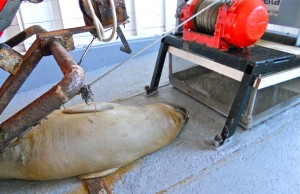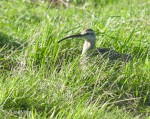Yesterday two Whimbrels were seen on the south shore of Great Race and this morning a posse of California Sea Lions was swimming about South Rocks barking in their distinctive manner. Garry alerted me to another weaner elephant seal pup on West Rocks. Today we have 5 e-girls here at the station: Bertha, Squall, Divot (she has raw sores/holes in her skin but seems otherwise healthy), Goat (this one crawled up to the weather station in the middle of the island), and 5086 (Fifty/Fiddy) whom I believe we first saw in December. I had thought Squall had left as I didn’t see her for a few days but turns out she had crawled up into the boathouse to get some peace and quiet!
Plenty of recreational fisherfolk are fringing the reserve. I suppose it makes a cunning sort of sense to hunt near the place where most of the fish are, but there is a self-serving element to that way of thinking that is reflective of why we need to have parks, reserves and preserves in the first place! Personally I prefer finding my dinner on the shore within the intertidal zone where I can be sure of what I am catching and can ensure there are plenty left to restock the locale. Unfortunately for me I won’t be eating creatures from the reserve though!
Today 6 kayakers lingered for quite a while at Middle Rocks; the Sea Lions didn’t like it and went in the water. We think of kayaks as benign but i have found that most animals prefer to know when the humans are coming and kayaks allow us to sneak up on them, ironically causing more panic than a motorized vessel. Yesterday I observed a huge submarine pass within 2 miles of the island. I reckon it was a Trident nuclear sub as it was escorted by the American Coast Guard. I can’t imagine the Sea Lions liked that either!














